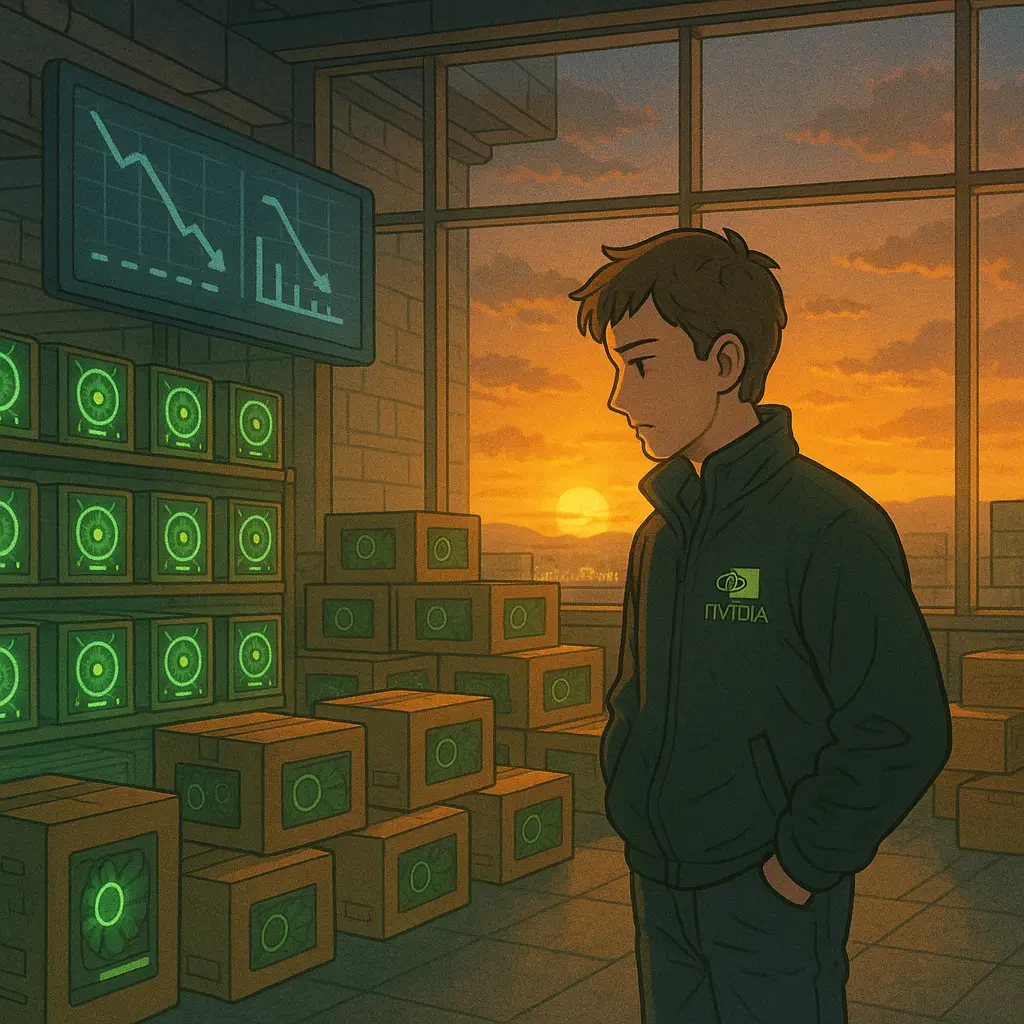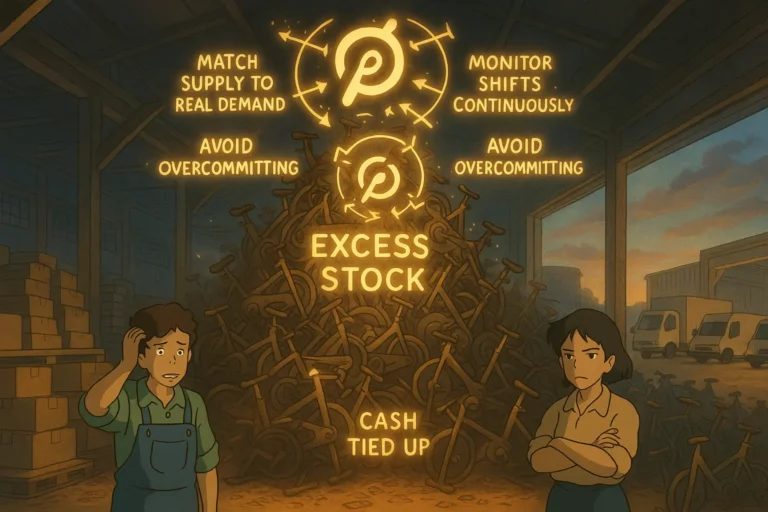
NVIDIA's Inventory Write-Down
Think of a wave that looks harmless at first but then hits with a force that leaves destruction in its wake. That was the story behind NVIDIA’s inventory write-down episode in 2018.
The crypto-driven GPU shortage pushed demand to extreme levels, then collapsed without warning, which left NVIDIA exposed. It was a real-life demonstration of the fact that even the best-in-class supply chain team is not immune to the illusions of a booming market.
In this article, we will explore why it happened, how it unfolded, and what it signifies for businesses that operate in volatile demand environments.
Key Nuggets:
- NVIDIA misread crypto mining demand and boosted GPU production beyond what the gaming market needed
- When crypto prices crashed, miners stopped buying, leaving NVIDIA’s supply chain with mountains of unsold GPUs
- The company recorded a $57M inventory write-down and saw gaming revenue fall 45%
- African supply chains can learn from this by tracking demand shifts more quickly and segmenting customers more effectively.
Background Story Behind NVIDIA’s Inventory Write-Down
NVIDIA’s supply chain troubles began when crypto miners swept up GPUs faster than the company could ship them. They had discovered that the company’s gaming GPUs were highly effective for mining, so these miners bought up large quantities of the graphics cards.
That situation created a crypto-driven GPU shortage that distorted demand enough to push the Prices of these GPU chips to extreme highs. Meanwhile, the gamers who were NVIDIA’s traditional customer base were met with empty shelves.
Demand was so great that some cards were sold at twice their normal price during the boom.
NVIDIA initially benefited from the surge, as revenue skyrocketed. However, the company lacked sufficient visibility into how much of this growth was driven by crypto mining versus genuine gaming demand.
When the cryptocurrency bubble burst in late 2018, miners who had methodically grabbed whatever GPUs were on the market suddenly wanted to get rid of them as the cryptocurrency market became less profitable.
Their solution was to flood the secondary market with these GPUs. So, suddenly, GPUS that were hard to get only a moment ago were overabundant in the market.
Unfortunately for NVIDIA’s supply chain, that meant they were sitting on a lot of inventory that had been planned to satisfy the demand surge, but was suddenly unable to sell.
Executives later admitted they misread the situation. Jensen Huang, the CEO, referred to the aftermath as a “crypto hangover,” a phrase that aptly captures the pain of the downturn.
Read More: How Tech Powered Record-Breaking Alibaba’s Singles’ Day Delivery in 2020.
The Impact of The CryptoCurrency Burst and NVIDIA’s Inventory Write Down
The crash hit NVIDIA hard.
Gaming revenue fell 45% in Q4 FY2019, which was historic because it was the company’s first revenue drop in years. Total revenue fell 24% year over year in that quarter.
NVIDIA reported a $57 million inventory write-down related to older GPUs that were stuck in the channel. And the stock price slid more than 50% from its peak, wiping out $20 billion in market capitalization.
Huang said Q4 was “extraordinary, unusually turbulent, and disappointing,” a comment that showed the scale of the shock. The drop also disrupted the company’s momentum and forced the supply chain to reassess how it would handle future spikes.
Read More: The Reason Behind Morrisons’ Digital Supply Chain Twin In 2025.
How NVIDIA’s Supply Chain Reacted
NVIDIA did not foresee the collapse, which led to an inventory management failure that froze the company’s supply chain.
The company’s CFO, Colette Kress, confirmed that post-crypto inventory of GPUs in the channel forced NVIDIA to reduce shipments, allowing retailers to clear their existing stock. A clear illustration of how the slowdown forced a reset.
Following the crisis, the company introduced options that separated miners from gamers to prevent the former from draining the gaming supply. Examples of these were the CMP units, which are miner-only chips.
NVIDIA also added hash-rate limiters to gaming cards, making them less attractive for mining.
These steps helped protect gaming customers and reduce the chance of another sudden boom wiping out the channel.
Do you want more supply chain stories like this? Subscribe here.
Lessons from NVIDIA’s Inventory Write-Down
Although experts at the time praised NVIDIA’s reaction, supply chains can avoid a similar episode if they learn critical lessons from NVIDIA’s inventory write-down. Some of these lessons include:
1. Separate Temporary Demand From Long-Term Demand
The impact of crypto mining demand was significant. But it came from a customer group with no loyalty and an unpredictable cycle. It was a hard lesson on the fact that not all demand deserves equal weight.
If your business sells to a segment driven by price swings or speculation, that segment should never shape its long-term production plan. For instance, a food producer that sees a spike in demand during the summer holidays should not expand its factories based on seasonal buyers.
2. Build Better Supply Chain Visibility
NVIDIA’s inventory write-down happened because its supply chain lacked visibility into the number of GPUs being acquired by miners (a temporary or uncertain customer at the time).
That gap made forecasting dangerous.
Without clear sell-through data, the company misread the true demand from its traditional customer base—the gamers. Better visibility would have shown that the spike came from a segment that could disappear at any moment.
3. Build a Supply Chain That Can Scale Down As Fast As It Can Scale Up
Most supply chains are too focused on how to grow or scale up operations, but very few consider putting measures in place to ensure they can scale down just as fast.
NVIDIA reacted late when demand dropped. By the time the supply chain was able to slow shipments, the channel was already full. A fast exit plan could have saved the company millions in stock write-downs.
4. Use Scenario Plans For Volatile Markets
NVIDIA’s supply chain later adopted tools that allowed it to simulate demand changes and run “what if” models, which helped it spot early signs of a drop and prepare faster.
Tools that support demand forecasting in tech or any other sector can help your supply chain avoid unnecessary surprises. With scenario planning, your supply chain can build resilience in the face of uncertainty.
Read More: How Tech Powered Record-Breaking Alibaba’s Singles’ Day Delivery in 2020.
How African Supply Chains Can Apply These Lessons
African supply chains face unique challenges compared to the rest of the world. Nevertheless, the lessons from here can be applied to the current realities through the following:
1. Track New Demand Spikes With Discipline
Many African suppliers experience sudden spikes from new sectors, such as fintech, hardware, last-mile mobility, or consumer electronics. However, these spikes can mislead teams into building excessive supply.
Like NVIDIA, they must treat any new surge with caution. Track these waves and cater to them, but do not assume they will last.
2. Segment Customers Clearly
Distinguish between long-term and short-term buyers. For example, if a business in Lagos orders large volumes once, treat that volume as temporary until it is proven to be a stable demand.
Allocate stock in a way that protects your loyal customers, not speculative buyers.
3. Improve Supply Chain Visibility
Many African markets rely on distributors who hold their own sales data. Supply chains can build agreements that leverage this to provide visibility into actual sell-through.
Even simple weekly updates from resellers can help prevent stock build-up. NVIDIA’s inventory struggles highlight the consequences of being unable to track the movement of goods after they leave the warehouse.
4. Use Basic Scenario Planning Tools
You do not need advanced systems to run scenarios, especially when simpler and more cost-effective tech solutions are available that can help them think through extreme cases and protect their operations.
NVIDIA shifted after the crash because it adopted tools that gave early warning signals.
Do you want more supply chain stories like this? Subscribe here.

Obinabo Tochukwu Tabansi is a supply chain digital writer (Content writer & Ghostwriter) helping professionals and business owners across Africa learn from real-world supply chain wins and setbacks and apply proven strategies to their own operations. He also crafts social content for logistics and supply chain companies, turning their solutions and insights into engaging posts that drive visibility and trust.








